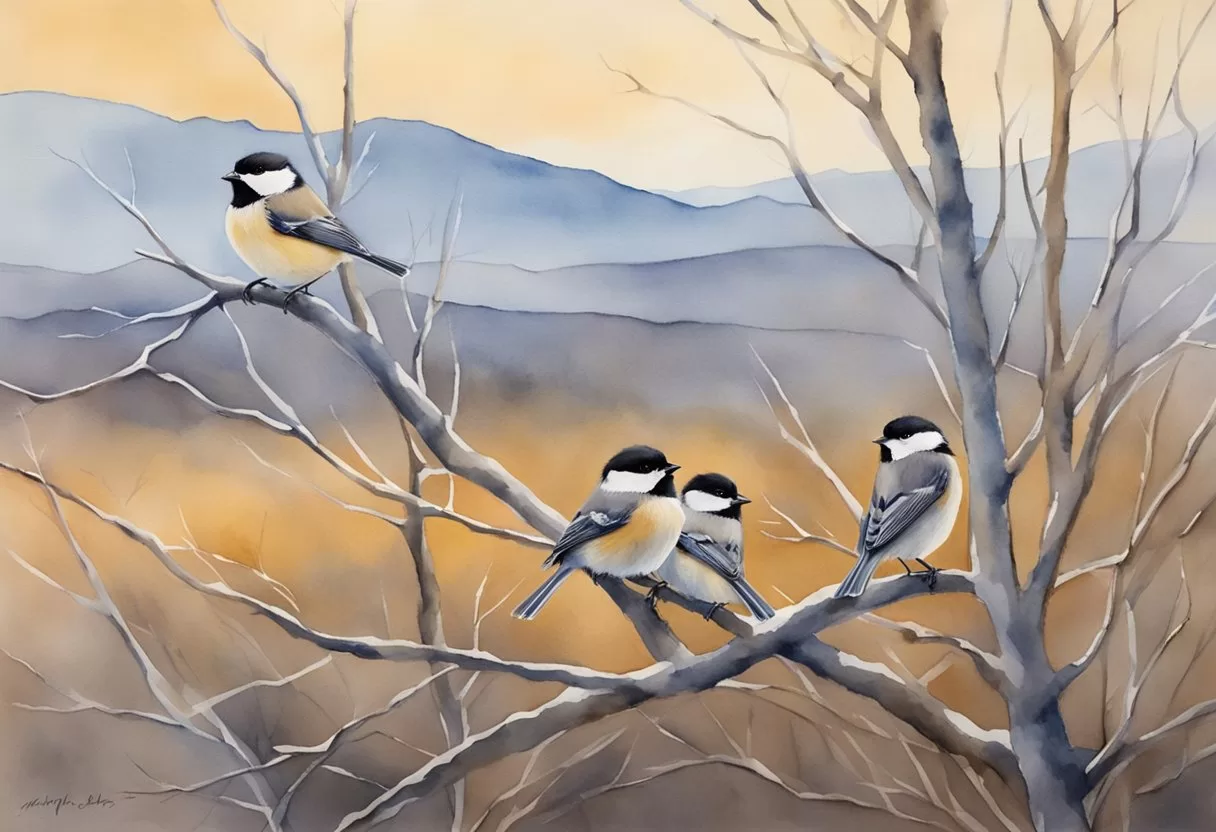The Impact of Climate Change on Chickadee Habitats
Climate change significantly influences the habitats of chickadees, altering their living conditions and interactions. Variations in temperature and shifting distribution patterns threaten these birds, leading to increased hybridization among species.
Temperature Variations and Their Direct Effects
Rising temperatures affect chickadees in various ways. As winter temperatures increase, chickadees must adapt to a shorter period of cold weather, impacting their breeding cycles and food availability. For instance, Black-capped chickadees face challenges as changes in temperature can lead to mismatched timing between food sources and nesting.
Cold spells can also lead to increased mortality rates. In extreme weather events, such as heavy snowfall or intense storms, chickadees struggle to find food and shelter, leading to lower survival rates during winter months. Their reliance on specific habitats makes temperature shifts particularly concerning.
Altered Distribution Patterns of Chickadee Species
Climate change drives chickadee species distributions northward. Research indicates that Carolina chickadees are now expanding their range, pushing north as warmer temperatures alter their natural habitats. This shift has implications for their mating patterns and competition with Black-capped chickadees who traditionally occupy these northern areas.
In regions where both species now overlap, competition for resources becomes intensified. As the hybrid zone moves northward, it affects the geographical distribution of chickadee species and alters interactions, thus impacting the ecological balance within these areas.
Hybridization Between Chickadee Populations
Hybridization between Carolina and Black-capped chickadees occurs more frequently due to the changing climate. As these species’ ranges overlap, hybridization can lead to the creation of hybrids that may possess unique traits but could also face challenges in survival and reproduction.
These mixed offspring adapt differently to environmental stresses, which raises questions about the long-term viability of these hybrids. The dynamics within the hybrid zone are complex, as climate change disrupts traditional habitats and creates opportunities for interbreeding, ultimately affecting species distributions and overall population health.
Adaptations and Survival Strategies in a Changing Climate

Chickadees are facing significant challenges from climate change, affecting their habitats and survival. Understanding how they adapt to extreme conditions, utilize cognitive skills, and modify reproductive behaviors is crucial for comprehending their response to a warming world.
Coping with Extremes: Snow Cover and Food Scarcity
As winter temperatures rise and snow cover fluctuates, chickadees must adapt their foraging strategies. Snow depth can influence their access to food, particularly seeds and insects. In snowy conditions, they rely on spatial memory to locate cached food.
Food scarcity exacerbates competition among chickadee species. They exhibit behaviors such as flocking to improve foraging efficiency. These adaptations are essential for survival, especially when food availability is low. Chickadees that efficiently locate food caches have better survival odds during harsh winters.
The Significance of Spatial Memory and Cognitive Skills
Chickadees are known as food-storing specialists, demonstrating remarkable cognitive abilities. Their spatial memory allows them to remember the locations of food caches, which is vital during periods of food scarcity.
Research shows that chickadees can recall the sites of thousands of stored items. This skill is particularly important when winter temperatures rise, leading to increased competition for limited resources. Strong memory skills not only improve foraging success but also contribute to the overall resilience of these birds in a changing climate.
Reproductive Responses to Environmental Changes
Climate change impacts reproductive behaviors in chickadees. Warmer temperatures may lead to earlier laying dates and increased clutch sizes, but these changes depend heavily on food availability. If resources are scarce, breeding success can decline.
Chickadees are sensitive to environmental cues, influencing their reproductive timing. For example, a decrease in winter temperatures may delay breeding, affecting nesting success. Adaptive strategies in reproduction are crucial for ensuring that chicks have the best chances of survival in fluctuating climates, emphasizing the importance of environmental stability for their life cycles.
Conservation Efforts and Citizen Science Contributions
Efforts to conserve chickadees and other avian species have significantly evolved with the integration of citizen science initiatives. These programs enable individuals to contribute valuable data that informs conservation strategies and enhances the understanding of environmental changes affecting bird populations.
Monitoring Changes in Avian Habitats and Populations
Citizen science projects like eBird, run by the Cornell Lab of Ornithology, play a crucial role in monitoring chickadee populations. Through this platform, birdwatchers report their observations, helping researchers track changes in distribution and abundance across different regions.
This crowdsourced data allows scientists to correlate bird sightings with temperature records and other environmental factors. These analyses reveal how warming temperatures impact chickadee habitats and behaviors. Genetic analyses of blood samples from various chickadee populations also provide insights into adaptation processes amid changing climates.
Public Engagement Through Citizen-Science Projects
Engaging the public is essential for the success of conservation initiatives. Programs often encourage the installation of bird feeders to attract chickadees, fostering a connection between individuals and local biodiversity. This interaction not only enhances public interest in avian species but also nourishes chickadee populations during critical winter months.
By participating in citizen science, community members report their observations, contributing to a larger database that informs conservation efforts. These contributions empower individuals to understand the impacts of temperature changes and environmental factors on chickadees, ultimately promoting a collective responsibility for their preservation.
Share this content:

Post Comment
You must be logged in to post a comment.